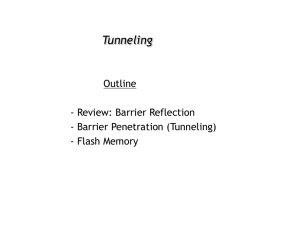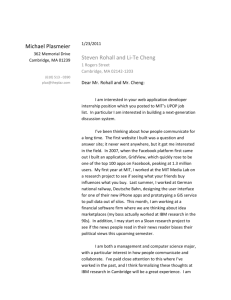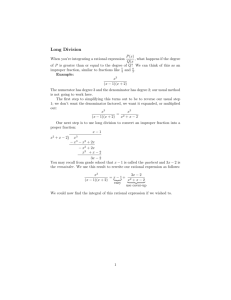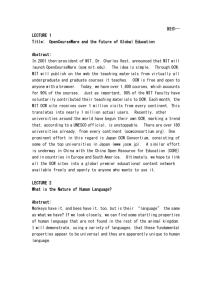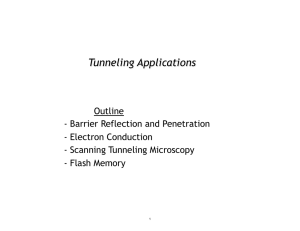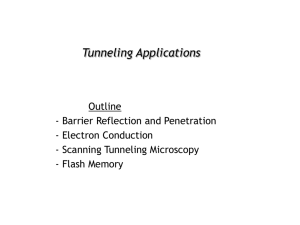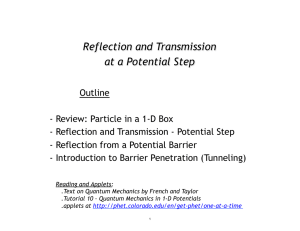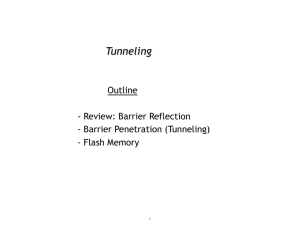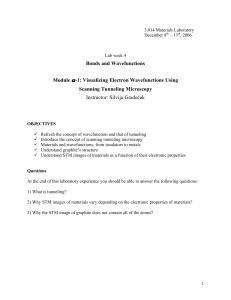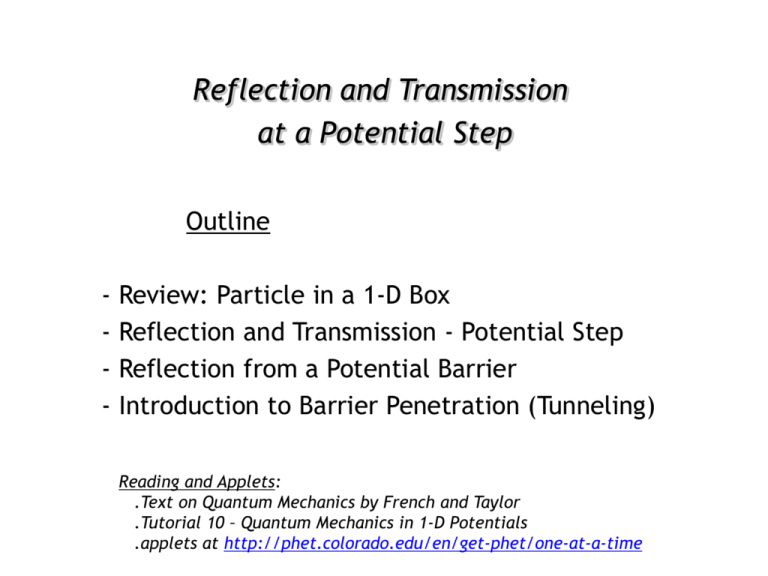
Reflection and Transmission
at a Potential Step
Outline
-
Review: Particle in a 1-D Box
Reflection and Transmission - Potential Step
Reflection from a Potential Barrier
Introduction to Barrier Penetration (Tunneling)
Reading and Applets:
.Text on Quantum Mechanics by French and Taylor
.Tutorial 10 – Quantum Mechanics in 1-D Potentials
.applets at http://phet.colorado.edu/en/get-phet/one-at-a-time
Schrodinger: A Wave Equation for Electrons
(free-particle)
(free-particle)
..The Free-Particle Schrodinger Wave Equation !
Erwin Schrödinger (1887–1961)
Image in the Public Domain
Schrodinger Equation and Energy Conservation
The Schrodinger Wave Equation
The quantity | |2 dx is interpreted as the probability that the particle can be
found at a particular point x (within interval dx)
n=3
0
L
x
© Dr. Akira Tonomura, Hitachi, Ltd., Japan. All rights reserved. This content is
excluded from our Creative Commons license. For more information, see
http://ocw.mit.edu/fairuse.
Schrodinger Equation and Particle in a Box
EIGENENERGIES for
1-D BOX
EIGENSTATES for
1-D BOX
PROBABILITY
DENSITIES
Semiconductor Nanoparticles
(aka: Quantum Dots)
Core Shell
Core
Quantum
Dot
Determining QD energy
using the Schrödinger Equation
Red: bigger dots!
Blue: smaller dots!
Photo by J. Halpert
Courtesy of M. Bawendi Group, Chemistry, MIT
LBLUE QD
LRED QD
Solutions to Schrodinger’s Equation
The kinetic energy of the electron is related to the
curvature of the wavefunction
Tighter confinement
Higher energy
Even the lowest energy bound state requires some wavefunction
curvature (kinetic energy) to satisfy boundary conditions
Nodes in wavefunction
Higher energy
The n-th wavefunction (eigenstate) has (n-1) zero-crossings
The Wavefunction
•
•
corresponds to a physically meaningful quantity –
- the probability of finding the particle near x
is related to the momentum probability density - the probability of finding a particle with a particular momentum
PHYSICALLY MEANINGFUL STATES MUST HAVE THE FOLLOWING PROPERTIES:
(x) must be single-valued, and finite
(finite to avoid infinite probability density)
(x) must be continuous, with finite d /dx
(because d /dx is related to the momentum density)
In regions with finite potential, d /dx must be continuous
(with finite d2 /dx2, to avoid infinite energies)
There is usually no significance to the overall sign of (x)
(it goes away when we take the absolute square)
(In fact, (x,t) is usually complex !)
Solutions to Schrodinger’s Equation
y(x)
In what energy level is the particle? n = …
(a) 7
(b) 8
x
(c) 9
What is the approximate shape of the
potential V(x) in which this particle is
confined?
L
V(x)
V(x)
V(x)
(a)
(b)
(c)
E
L
E
L
E
L
WHICH WAVEFUNCTION CORRESPONDS TO WHICH POTENTIAL WELL ?
(A)
(1)
(B)
(2)
(C)
(3)
NOTICE THAT FOR FINITE POTENTIAL WELLS WAVEFUNCTIONS ARE NOT ZERO AT THE WELL BOUNDARY
A Simple
Potential Step
CASE I : Eo > V
Region 1
In Region 1:
In Region 2:
Region 2
A Simple
Potential Step
CASE I : Eo > V
Region 1
is continuous:
is continuous:
Region 2
A Simple
Potential Step
CASE I : Eo > V
Region 1
Region 2
Example from: http://phet.colorado.edu/en/get-phet/one-at-a-time
Quantum Electron Currents
Given an electron of mass
that is located in space with charge density
and moving with momentum
corresponding to
… then the current density for a single electron is given by
A Simple
Potential Step
CASE I : Eo > V
Region 1
Region 2
A Simple
Potential Step
CASE I : Eo > V
Region 1
1
1
Region 2
IBM Almaden STM of Copper
Image originally created by the IBM Corporation.
© IBM Corporation. All rights reserved. This content is excluded from our Creative Commons
license. For more information, see http://ocw.mit.edu/fairuse.
Image originally created by the IBM Corporation.
IBM Almaden
© IBM Corporation. All rights reserved. This content is excluded from our Creative Commons
license. For more information, see http://ocw.mit.edu/fairuse.
IBM Almaden
Image originally created by the IBM Corporation.
© IBM Corporation. All rights reserved. This content is excluded from our Creative Commons
license. For more information, see http://ocw.mit.edu/fairuse.
A Simple
Potential Step
CASE II : Eo < V
Region 1
In Region 1:
In Region 2:
Region 2
A Simple
Potential Step
CASE II : Eo < V
Region 1
is continuous:
is continuous:
Region 2
A Simple
Potential Step
CASE II : Eo < V
Region 1
Total reflection Transmission must be zero
Region 2
Quantum Tunneling Through a Thin Potential Barrier
Total Reflection at Boundary
Frustrated Total Reflection (Tunneling)
KEY TAKEAWAYS
CASE I : Eo > V
A Simple Potential Step
Region
1
Region
2
Region
1
Region
2
PARTIAL REFLECTION
CASE II : Eo < V
TOTAL REFLECTION
A Rectangular
Potential Step
CASE II : Eo < V
Region 1
In Regions 1 and 3:
In Region 2:
for Eo < V :
Region 2
Region 3
A Rectangular
Potential Step
for Eo < V :
Flash Memory
Stored
Electrons
Programmed
“0”
Erased
“1”
Image is in the public domain
CONTROL GATE
Tunnel Oxide
Insulating
Dielectric
Floating
Gate
FLOATING GATE
SOURCE
CHANNEL
Substrate
Electrons tunnel preferentially when a voltage is applied
DRAIN
Channel
MOSFET: Transistor in a Nutshell
Conduction electron flow
Control Gate
Conducting Channel
Image courtesy of J. Hoyt Group, EECS, MIT.
Photo by L. Gomez
Semiconductor
Image courtesy of J. Hoyt Group, EECS, MIT.
Photo by L. Gomez
Tunneling causes thin insulating layers
to become leaky !
Image is in the public domain
Reading Flash Memory
UNPROGRAMMED
PROGRAMMED
CONTROL GATE
CONTROL GATE
FLOATING GATE
FLOATING GATE
SILICON
To obtain the same channel charge, the programmed gate needs a
higher control-gate voltage than the unprogrammed gate
How do we WRITE Flash Memory ?
Example: Barrier Tunneling
• Let’s consider a tunneling problem:
An electron with a total energy of Eo= 6 eV
approaches a potential barrier with a height of
V0 = 12 eV. If the width of the barrier is
L = 0.18 nm, what is the probability that the
electron will tunnel through the barrier?
V0
Eo
metal
metal
0 L air
gap
Question: What will T be if we double the width of the gap?
x
Multiple Choice Questions
Consider a particle tunneling through a barrier:
1. Which of the following will increase the
likelihood of tunneling?
a. decrease the height of the barrier
b. decrease the width of the barrier
c. decrease the mass of the particle
V
Eo
0 L
2. What is the energy of the particles that have successfully “escaped”?
a. < initial energy
b. = initial energy
c. > initial energy
Although the amplitude of the wave is smaller after the barrier, no
energy is lost in the tunneling process
x
Application of Tunneling:
Scanning Tunneling Microscopy (STM)
Due to the quantum effect of “barrier penetration,” the
electron density of a material extends beyond its surface:
material
One can exploit this
to measure the
electron density on a
material’s surface:
Sodium atoms
on metal:
STM tip
~ 1 nm
material
E0
STM tip
V
Single walled
carbon nanotube:
STM images
Image originally created
by IBM Corporation
© IBM Corporation. All rights reserved. This content is excluded from our Creative
Commons license. For more information, see http://ocw.mit.edu/fairuse.
Image is in the public domain
MIT OpenCourseWare
http://ocw.mit.edu
6.007 Electromagnetic Energy: From Motors to Lasers
Spring 2011
For information about citing these materials or our Terms of Use, visit: http://ocw.mit.edu/terms.

